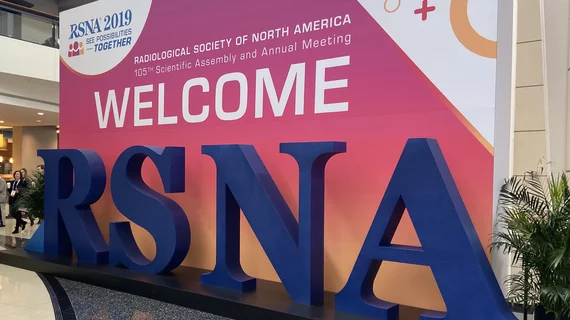RSNA 2019: A revised perspective is central to a new era of patient-centered radiology
Radiology has been at the forefront of many technological advances in medicine, but imaging experts may need to adjust their perspective if they want to continue leading the field.
That was the message delivered during Sunday’s presidential address at the Radiological Society of North America 2019 annual meeting. RSNA President Valerie P. Jackson, MD, urged radiologists to look within themselves, step out of the reading room and connect with others in order to move toward the “long desired goal” of more direct patient connection.
The timing is particularly important, said Jackson, who is also executive director of the American Board of Radiology, given the ballooning number of burned out physicians, an ever-increasing focus on value-based care, and the potential for AI to assume time-consuming tasks and afford radiologists more time to interact with patients.
Incorporating the patient perspective
Jackson, a longtime photography enthusiast, suggested that a few basic principles of her favorite hobby may help radiologists see things from a fresh angle. She pointed to three specific examples to illustrate her point.
Just like a macro lens offers close-up, detailed views, radiologists need to take a closer look at customer experience and ask themselves how patients feel. What do they want to know? How would you want to be treated? In today’s world, a patient wants more information in less time, she said.
A first step, Jackson explained, is to make a commitment to go into the waiting room, if possible, and introduce yourself to the patient as their radiologist. Ask about their care and explain the radiologist's role on the care team.
“In radiology we tend to think of images that we read as objects. Let’s remember that every study we read is on a person, with the same feelings, fears and concerns that we have,” she said.
Referring physicians can help
Switching to a wide-angle lens can capture moments invisible to a traditional lens. Radiologists need to make this adjustment, Jackson said, and partner with referring physicians.
Put territorial issues aside, she said, and realize that the two professions are “natural partners,” with technology making it easier than ever to communicate with one another.
Jackson suggested learning about a referring physician's needs to help foster a better working relationship. Collaborating to develop new communication tools is also a good place to start, she added.
Look in the mirror
Radiologists, like most physicians, are suffering from increasing rates of burnout, higher case volumes and expectations that they must interpret images quicker than ever before. Similar to how a photographer uses a telephoto lens to zoom in from afar, radiologists need to perform a bit of close-up self-examination, Jackson said.
Although some radiologists undoubtedly pursued the profession for its solidarity, Jackson believes many imaging experts are more equipped to talk with patients than they realize. A self-described introvert, she argues that the extra effort it takes to step outside the reading room is ultimately worth it.
“We (radiologists) are heading toward a future in which patients are going to want and need to hear from us more than ever before…we owe it to them to respond,” she said. “I know we can do it and each small effort on our part, individually, will add to the collective momentum in creating a new culture of patient interaction within radiology.”

